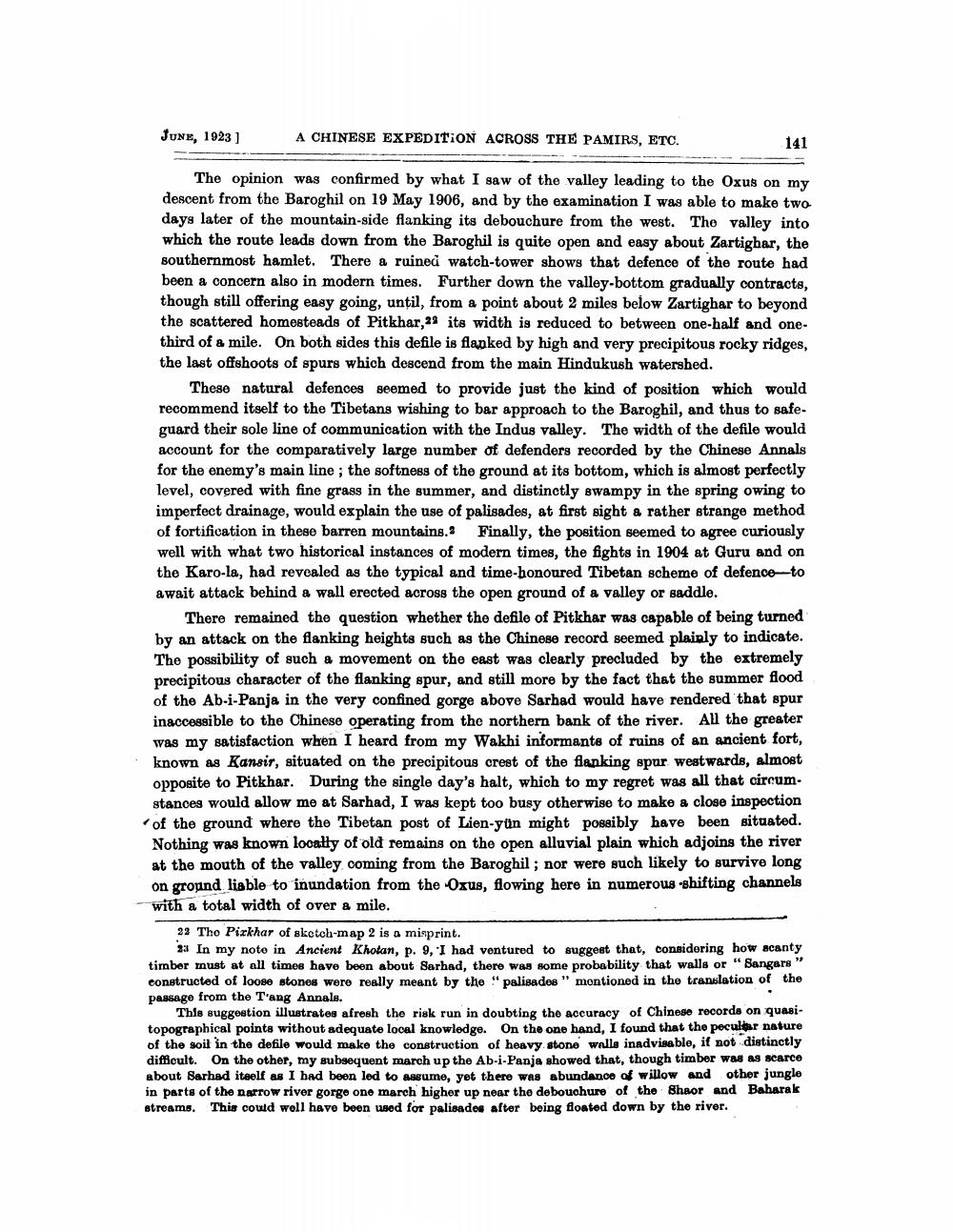________________
June, 1923]
A CHINESE EXPEDITION ACROSS THE PAMIRS, ETC.
141
The opinion was confirmed by what I saw of the valley leading to the Oxus on my descent from the Baroghil on 19 May 1906, and by the examination I was able to make two days later of the mountain-side flanking its debouchure from the west. The valley into which the route leads down from the Baroghil is quite open and easy about Zartighar, the southernmost hamlet. There a ruined watch-tower shows that defence of the route had been a concern also in modern times. Further down the valley-bottom gradually contracts, though still offering easy going, until, from a point about 2 miles below Zartighar to beyond the scattered homesteads of Pitkhar, 29 its width is reduced to between one-half and onethird of a mile. On both sides this defile is flanked by high and very precipitous rocky ridges, the last offshoots of spurs which descend from the main Hindukush watershed.
These natural defences seemed to provide just the kind of position which would recommend itself to the Tibetans wishing to bar approach to the Baroghil, and thus to safe. guard their sole line of communication with the Indus Valley. The width of the defile would account for the comparatively large number of defenders recorded by the Chinese Annals for the enemy's main line ; the softness of the ground at its bottom, which is almost perfectly level, covered with fine grass in the summer, and distinctly swampy in the spring owing to imperfect drainage, would explain the use of palisades, at first sight a rather strange method of fortification in these barren mountains. Finally, the position seemed to agree curiously well with what two historical instances of modern times, the fights in 1904 at Guru and on the Karo-la, had revealed as the typical and time-bonoured Tibetan scheme of defence-to await attack behind a wall erected across the open ground of a valley or saddle.
There remained the question whether the defile of Pitkhar was capable of being turned by an attack on the flanking heights such as the Chinese record seemed plainly to indicate. The possibility of such a movement on the east was clearly precluded by the extremely precipitous character of the flanking spur, and still more by the fact that the summer flood of the Ab-i-Panja in the very confined gorge above Sarhad would have rendered that spur inaccessible to the Chinese operating from the northern bank of the river. All the greater was my satisfaction when I heard from my Wakhi informants of ruins of an ancient fort, known as Kansir, situated on the precipitous crest of the flanking spar westwards, almost opposite to Pitkhar. During the single day's halt, which to my regret was all that circumstances would allow me at Sarhad, I was kept too busy otherwise to make a close inspection of the ground where the Tibetan post of Lien-yün might possibly have been situated. Nothing was known locally of old remains on the open alluvial plain which adjoins the river at the mouth of the valley coming from the Baroghil; nor were such likely to survive long on ground liable to inundation from the Oxus, flowing here in numerous shifting channels with a total width of over & mile.
23 Tho Pixkhar of sketch-map 2 is a misprint.
33 In my noto in Ancient Khotan, p. 9, I had ventured to suggest that, considering how scanty timber must at all times have been about Sarhad, there was some probability that walls or "Sangars" constructed of loose stonos were really meant by the " palisados " montioned in the translation of the passage from the T'ang Annals.
This suggestion illustrates afresh the risk run in doubting the accuracy of Chinese records on quasitopographical points without adequate local knowledge. On the one hand, I found that the peculour nature of the soil in the defile would make the construction of heavy stone walls inadvisable, if not distinctly difficult. On the other, my subsequent march up the Ab-i-Panja showed that, though timber was ag scarce about Sarhad itself as I had been led to assume, yet there was abundance of willow and other jungle in parts of the narrow river gorge one march higher up near the debouchure of the shaor and Baharak streams. This could well have been used for palisadeg after being floated down by the river.




